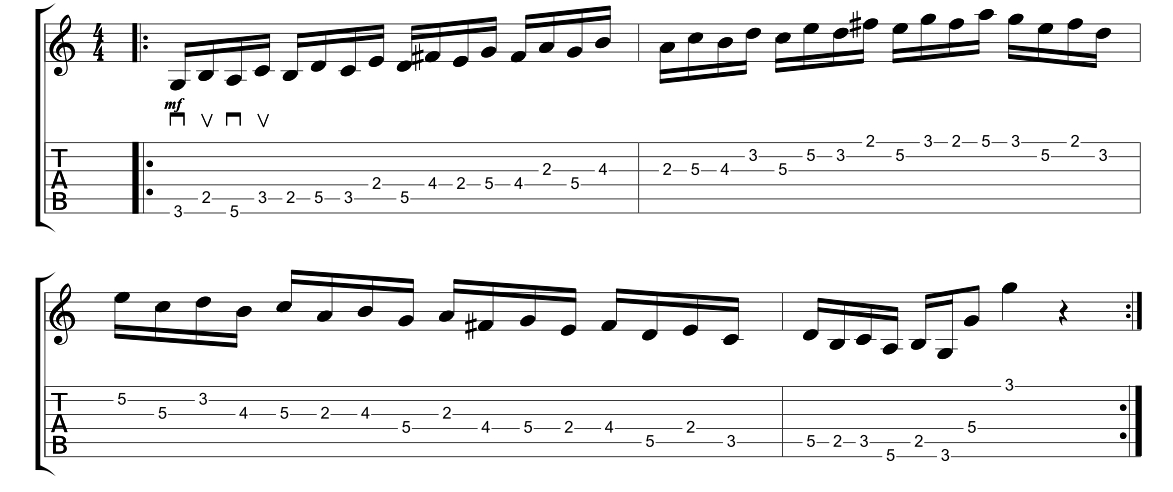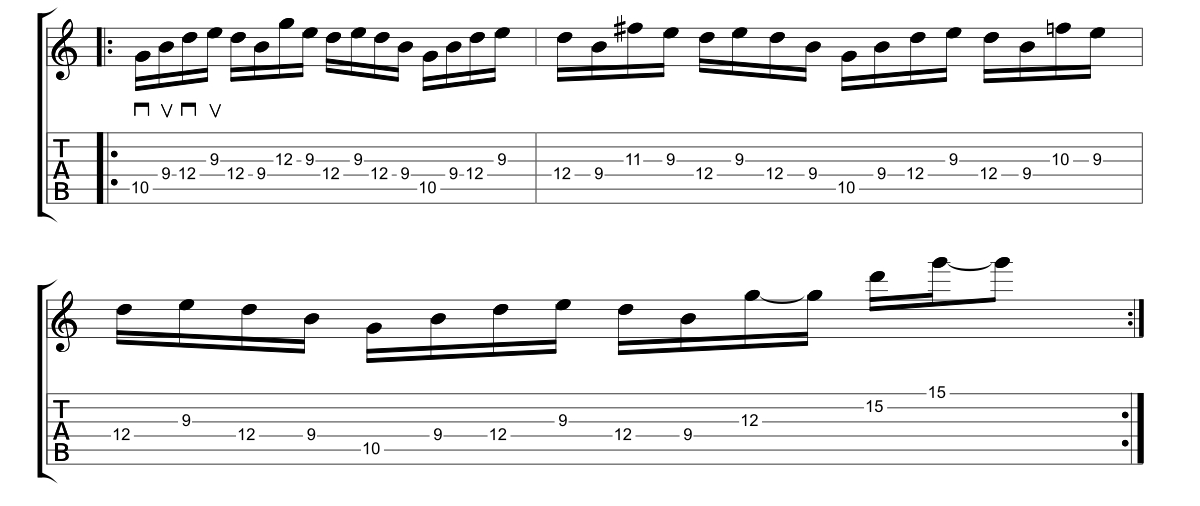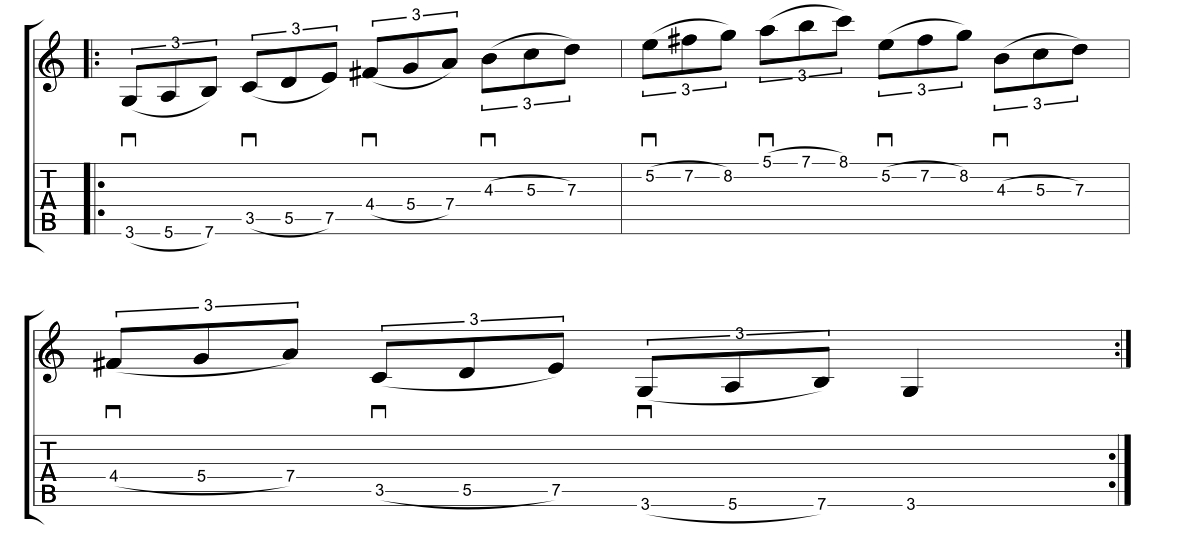Melodic Guitar Patterns
In the previous lesson, I showed you some practical ways to improve your dexterity and coordination through a series of five carefully picked exercises. Today, I am going to show you part two of my guitar warm up regime. By creating melodic patterns and sequences on the guitar, you will not only warm up quickly and efficiently, but they will act as lick and riff builders in your own playing!
Guitar Patterns Example 1 – G Major Sequence
Example one is a very common pattern used to practice scales. I have demonstrated the sequence using the G major scale, but you can apply the pattern to any scale pattern that you wish. Once you have mastered the sequence, I want you to try only moving a finger when it is needed to fret a note. This teaches you to apply minimal movement throughout this scale, something that will help develop speed later on. Watch the YouTube video to see how I use this technique!

Guitar Patterns Example 2 – G Major 7 Arpeggio
We need to warm up all areas of our playing, so now we will concentrate on some arpeggios. Example two demonstrates a G major 7 arpeggio based around the ‘E’ shape.

Guitar Patterns Example 3 – G minor 7 Arpeggio
Now that you have mastered the G major 7 arpeggio, lets look at the G minor 7 arpeggio built around the ‘E’ shape.

Guitar Patterns Example 4 – G 7 Arpeggio
To finish off our arpeggio warm up, let’s look at a G7 arpeggio around the ‘E’ shape. Aim to stick to a ‘finger per fret’ basis when learning all the examples in this lesson.

Guitar Patterns Example 5 – 4 Finger Chord Change
Four-finger chord changes are always challenging and make a fantastic addition to any warm up. This example shows a G major 7 – Gmaj9 chord change which requires every finger to move independently. This chord sequence is very common in jazz and latin, making it both a practical warm up, and a useful rhythm playing progression.

Guitar Patterns Example 6 – Simon’s Pattern
A few years ago when I was studying at the Guitar Institute, I wanted one warm up that got my fingers and hands prepared for playing. I created this idea which I still use to this day. Start off very slowly with a metronome while learning this sequence, and be sure to use alternate picking (down up) throughout.

Guitar Patterns Example 7 – G Major Legato Pattern
In the final example, I have included a very simple G major scale 3 note per string legato pattern. This pattern uses all three different legato finger groupings and is the basis for further legato study!

Recommended listening
A lot of guitarists use melodic patterns but I first got into developing this technique by watching Steve Vai. I recommend buying the album “Passion And Warfare.” My favourite track on that album being “For The Love Of God”
Subscribe on Youtube
Make sure you log on and subscribe to our new YouTube Channel, dedicated to bringing you the finest free guitar lessons.
Guitar Lesson Video Transcription
Hey YouTube, Simon here once again for the incredible Fundamental Changes. Today we’re going to look at part 2 of my Creating Your Own Personal Warm Up Regime, and we’re focusing on melodic sequences and patterns. Let’s go and have a look at a few examples, just after this.
In the previous lesson, part 1 of Creating the Perfect Warm up, I talked in depth about dexterity exercises, and I showed you some of my own personal favorites from finger-per-fret, right through to Satriani-type exercises, and everything in between.
Now, although those exercises are fantastic for getting your fingers moving and getting them warmed up quickly – that should probably be the first thing that you do if you can to keep your hands warm – It’s not particularly easy on the ear, because a lot of it is chromatic and a lot of it has dissonance to it.
Today we’re going to look at different examples of making your melodic sequences in your playing for warm ups as well. Let’s have a look at Number 1, which revolves around the G major scale.
[guitar playing]
I love patterns on the guitar. I love little moving shapes, moving phrases, and this is one of my favorite scale warm ups. Basically what happens is we’re using the G major scale that you’d probably be very familiar with (just a normal major scale shape), but you can apply this pattern to any scale shape you know, I would briefly show you how play it in a pentatonic in a second.
What you do is you start from the 1st note, you miss the 2nd note, you go to the 3rd note, 2nd note, 4th note, so the pattern goes 1st note, 3rd note, 2nd note, 4th note, 3rd note, 5th note, etc., etc.
You’re skipping out a note in the middle and building a fantastically usable little lick builder using the G major scale. Now if you have your A minor pentatonic, the guitarist world’s best friend, you’d start on the 5th fret, and you’d skip out the 2nd note, and you’d go 5. Then you come back to the 2nd note, 2, 4, 3, 5, etc., so you’re always skipping out a note there.
That is my favorite little melodic build-up warm up exercise using the G major scale. If you’re up for a real challenge with that last warm up exercise that you just learned there using the G major scale, what I want you to try is what’s called “Don’t move a finger until you need it to play a fret.” Basically your fret – the 3rd fret – say of the 6th string, which is the 1st note, you need the index or the 1st finger to come onto the 2nd fret of the 5th string. Now we need the 4th finger to come on to the 5th fret there.
You can see that that one is still on there. That 1st finger is still on that 2nd fret, and it’s going to stay there until it’s needed again within the pattern. You can practice this just with your scale shape at first. I recommend just taking a G major scale, and then going though it and don’t move a finger until it’s needed.
That is a really, really fun way to improve your minimal movement, which will ultimately improve your speed, something that let’s face it, we’re all after. Let’s go and have a look at a few arpeggios.
[guitar playing]
Example 2 there used a little G major 7 arpeggio, which obviously goes with G major 7 chord. We’re building a little warm up regime here that you can always adapt and progress, depending on where you are in your knowledge and your fret board skills.
For today, what I’ve done is I’ve created a G major 7 arpeggio here, a G minor 7 which is the next example, and a G dominant 7 arpeggio. What you want to do in your warm up is always have 1 arpeggio for each chord family: major, minor, and dominant.
Today we’ve got major 7, minor 7, dominant 7, but you might want to have major 9, dominant 9, and minor 9, or 11th, or any other arpeggios you know, but you want to have 1 of each. You’re going to start off with your scale pattern in Example 1, then the major 7 arpeggio we’re looking at here, and then the next 2 arpeggios. You can mix and match them as you like as your fret board develops.
This is just a core syllabus. Just try and build your own regime from this as well.
[guitar playing]
Example 3 there is quite simply the G minor 7 arpeggio. Once again, with all of these examples, as notated in the notation, try and use alternate picking, down-up-down-up-down-up, because that builds momentum, fluidity, and it’s something that you really want to warm up.
As well as your fretting hand, you want to warm up your picking hand as quickly as possible today with melodic sequences. We’ve done our G major 7 in the previous example, and G minor 7. As I said, you can extend or change this arpeggio as you wish. This is the base point for you to build your own regime from.
[guitar playing]
Final pattern in our little arpeggios part of today is a G dominant 7, or a G 7 arpeggio. All these shapes that I’ve shown today are just around the E shape or shape 1 of each of these arpeggios. Then you can now learn these in shape 2, shape 3, shape 4, and shape 5. You can build these up in as many different ways as you like to build your own perfect warm up regime with what you’re wanting to play, practice, work on, and the genre of music that you like as well.
You might want to change your arpeggios into a rockier format, or a funk, or a blues, or a jazz. It’s up to you, but you want to keep warming these up every time. Let’s look at the next example.
[guitar playing]
Something that I’ve noticed over my years teaching, and in my own playing, is people don’t tend to warm up chords. We have lots of single note things, and we sometimes do a few other little techniques and stuff like that, but very rarely do I see people warming up chords.
Now, you can do a variety of exercises here, but one that I love to do is the 4-finger chord change. I’ve given you a 2 chord sequence here today, which is a G major 7, which is 3rd fret of the 6th string, nothing, 4-4-3. Refer to the tablature in the article underneath this for these if you want to see the tabs, and then we’re going to go to a G major 9, 3, nothing, 4, 2, 3. Hopefully you can see that clearly, but I’ve had to move all 4 fingers to move through these chord shapes. What I like to do when I’m doing a 4 finger chord change, is I focus on where 1 finger has to be. In this case, I’m focusing where my 2nd or my middle finger has got to come all the way to the 6th string – to the G – and then my other fingers will fall underneath that.
This is a very classic jazz, bossa, latin-type pattern, because there aren’t too many 4-finger changes in rock, because it requires quite a lot of effort, and it can be quite challenging, but it’s a really fun one. You can get used to the change, and you can sit there, and it’s one you can do while you’re watching TV, or something on in the background, and you can just get your fingers used to a 4-finger change.
That warms them up in a specific chordal environment, something I really like to do in my own playing. Let’s look at the next example.
[guitar playing]
I’ve referred to this example as Simon’s idea, or Simon’s warm up. I created this little mini ditty many, many years ago, and I still use it to this day because it’s useful. What I like to do is I like to have something that’s fairly melodic, but also involves all 4 of my fingers, and in this case, alternate picking. Doesn’t have to, you can create examples that use legato, hammer-ons, pull offs, whatever you’re working on.
This one again is all around G, as most of the examples are today. You can see that we’re quite high up the neck here. It does feel a little bit weird playing this with a metronome because we’ve got 16th notes: 1 e & a, 2 e & a, 3 e & a, 4 e & a, but the bars are being cut slightly as to every 6th or 7th notes, depending on where they’re landing for the pattern itself.
I recommend every example barring with this one. You practice with a metronome, I did them 80 BPM, start at 60, work up. This one, try to get the pattern down without a metronome first, and refer to the tab. It’s a really fun little exercise that goes through little arpeggios, and a little melodic motif. I love those.
Let’s look at the final example today.
[guitar playing]
Nearly all of today’s examples have been warming up the picking hand using alternate picking, so I thought I’d leave the final example here as a very simple legato warm up. It’s not big heroics, it’s not shredmonger type thing, it’s just warming up all of the different main 3-note per string finger pattern that you’re going to come across in your own playing.
The major scale 3 note per string is 3-5-7, 3-5-7, 4-5-7, 4-5-7, 5-7-8, 5-7-8. You can see that there in your tablature notation. What I’ve done here is I’m picking the 1st note of each of these and then 2 hammer-ons on the way up: pick, hammer, hammer, pick, hammer, hammer all the way through.
On the way back I’ve done the exact same thing: pick, hammer, hammer, pick, hammer, hammer, pick, hammer, hammer. For those of you that want another challenge, on the way back you can go: pick, pull off, pull off, pick, pull off, pull off, pick, pull off, pull off, etc.
I’ve done it all hammer-ons today, but I want this to be your basis for your warm up regime. You can change it, you can adapt it, you can take 1 exercise and add it into the others, you can take 1 exercise from the dexterity of Satriani, and add it into just the 4-finger chord warm up. If you’ve only got 2 minutes to warm up, you can pick your favorites.
It doesn’t have to take hours, but if you do these everyday, you will build coordination, melodic phrases, and everything like that. These little warm ups, like the scale warm ups in Example 1, are fantastic way to build longer licks down the line. My favorite quote from when I was studying at the guitar institute was “I’ve only got 1 lick, but it’s half an hour long.”
The only reason you can build long licks like that is fret board fluency, dexterity, coordination and melodic sequences. We’re covering these all within this warm up regime.
I really hope you got something from these exercises. Take care. Any questions, please drop me a line below this video or underneath the article itself. I do read them, and I try to get back to all of you as quickly as possible.
Take care, see you soon.
Hi everyone, I hope you enjoyed this melodic patterns and sequences warm up lesson. I really hope you got something from it. Please like, comment, share and subscribe, and I will see you next time for way more videos.
“The artists you work with, and the quality of your work speaks for itself.”
Tommy Emmanuel
© Copyright Fundamental Changes Ltd 2025
No.6 The Pound, Ampney Crucis, England, GL7 5SA
